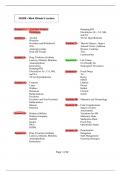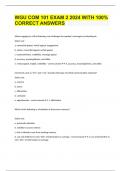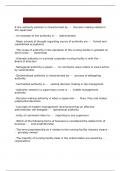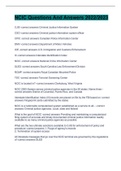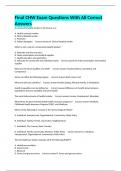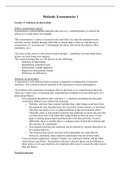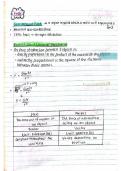BRAIN, BEHAVIOUR &
MOVEMENT
BBS1004
Abstract
[Trek de aandacht van uw lezer met een interessante samenvatting. Dit is meestal een kort
overzicht van het document.
Wanneer u uw inhoud wilt toevoegen, klikt u hier en begint u te typen.]
Arjen Kalisvaart
[E-mailadres]
, Case 01 BBS1004
WHAT IS A NEURON?
Microscopically, the nervous system is composed of nerve cells or called neurons and support cells
called glial cells. A neuron is a specialized cell that has lost its ability to divide, which means that the
neuron is in the G0 phase of the interphase. Neurons are mainly responsible for signalling in the
nervous system, although glia cells may contribute as well.
The types and shapes of the neurons can vary but they all consist of several underlining features:
• Dendrites = Projections of the cell body that receive electrical signals from other neurons.
• Cell body (soma) = Region of the neuron that contains the nucleus and other organelles of
the cell; ER, Golgi apparatus, ribosomes, mitochondria and microtubules.
• Axon Hillock = A special region of the cell body that connects to the axon. This is where the
action potential is generated.
1
, • Axon = A long extension of the nerve cell that is specialised to carry the electrical signal away
from the cell body and to the axon terminal.
• Axon terminal = Projections at the end of
an axon that are specialised to transmit
signals to the postsynaptic cell. At the end
of each projection is a bulb-shaped
structure (synapse) that can release
neurotransmitters, which are molecules
stimulate the postsynaptic cell. An axon can
have more branches which all lead to their
own synapse. In this axon terminal there
are no microtubules, contains a lot of
synaptic vesicles, which are small bubbles
of membrane and contains a lot of mitochondria.
• Synaptic cleft: Space between the presynaptic and postsynaptic membranes.
THREE TYPES OF NEURONS :
1. Sensory neurons
2. Motor neurons
3. Interneurons
2
, The cytoskeleton of a neuron exist of:
1. Microtubules → they run longitudinally down neurites. A microtubule is formed out of lots of
the same protein called tubulin.
2. Microfilaments → Are found everywhere in the neuron. Made out of polymers of actin.
3. Neurofilaments → These are also intermediate filaments but in neurons they are called this.
3
MOVEMENT
BBS1004
Abstract
[Trek de aandacht van uw lezer met een interessante samenvatting. Dit is meestal een kort
overzicht van het document.
Wanneer u uw inhoud wilt toevoegen, klikt u hier en begint u te typen.]
Arjen Kalisvaart
[E-mailadres]
, Case 01 BBS1004
WHAT IS A NEURON?
Microscopically, the nervous system is composed of nerve cells or called neurons and support cells
called glial cells. A neuron is a specialized cell that has lost its ability to divide, which means that the
neuron is in the G0 phase of the interphase. Neurons are mainly responsible for signalling in the
nervous system, although glia cells may contribute as well.
The types and shapes of the neurons can vary but they all consist of several underlining features:
• Dendrites = Projections of the cell body that receive electrical signals from other neurons.
• Cell body (soma) = Region of the neuron that contains the nucleus and other organelles of
the cell; ER, Golgi apparatus, ribosomes, mitochondria and microtubules.
• Axon Hillock = A special region of the cell body that connects to the axon. This is where the
action potential is generated.
1
, • Axon = A long extension of the nerve cell that is specialised to carry the electrical signal away
from the cell body and to the axon terminal.
• Axon terminal = Projections at the end of
an axon that are specialised to transmit
signals to the postsynaptic cell. At the end
of each projection is a bulb-shaped
structure (synapse) that can release
neurotransmitters, which are molecules
stimulate the postsynaptic cell. An axon can
have more branches which all lead to their
own synapse. In this axon terminal there
are no microtubules, contains a lot of
synaptic vesicles, which are small bubbles
of membrane and contains a lot of mitochondria.
• Synaptic cleft: Space between the presynaptic and postsynaptic membranes.
THREE TYPES OF NEURONS :
1. Sensory neurons
2. Motor neurons
3. Interneurons
2
, The cytoskeleton of a neuron exist of:
1. Microtubules → they run longitudinally down neurites. A microtubule is formed out of lots of
the same protein called tubulin.
2. Microfilaments → Are found everywhere in the neuron. Made out of polymers of actin.
3. Neurofilaments → These are also intermediate filaments but in neurons they are called this.
3

